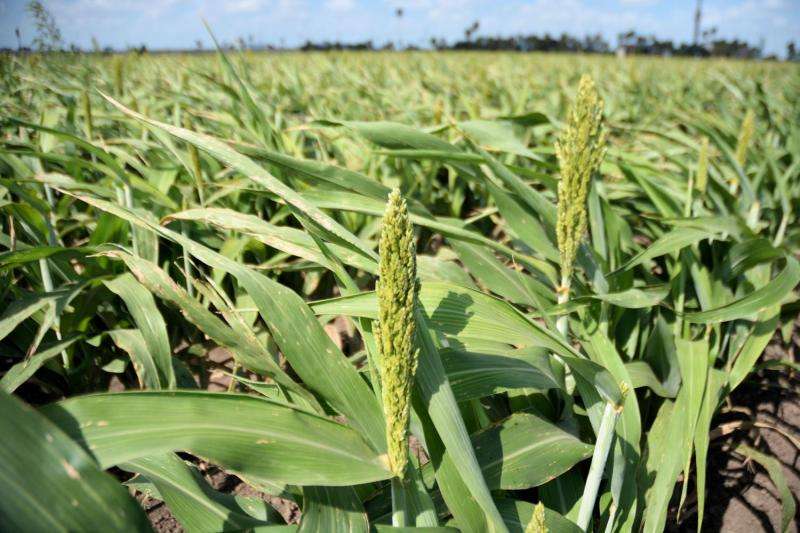Grain sorghum growers urged to look out for sugarcane aphids

Texas A&M AgriLife Extension Service experts in South Texas are warning grain sorghum growers to keep a sharp eye out for populations of sugarcane aphids. The tiny insects caused minimal damage to last year's crop due to wet conditions, but the recent dry spell could trigger explosive populations, they said.
"Warm and dry conditions have made it possible to get an early start on the grain sorghum crop, especially compared to 2015, but how might this year's conditions influence sugarcane aphid infestations?" asked Dr. Robert Bowling, an AgriLife Extension entomologist at the Texas A&M AgriLife Research and Extension Center at Corpus Christi.
Left unchecked, the aphids suck sap from plant leaves and deposit "honeydew," a sticky waste that clogs harvesting equipment, Bowling said. They can also move into the grain head, slowing the ripening process thus reducing both quality and yield.
Sugarcane aphid reproduction is favored by the weather conditions prevalent lately in the Coastal Bend and Lower Rio Grande Valley, he said.
"We've seen evidence as far north as Hill County suggesting sugarcane aphids are maturing and producing offspring," Bowling said. "It is possible they will start moving from their overwintering sites to sorghum this early in the season. So, it's important to know the path forward to protect the crop from sugarcane aphid injury in 2016."
First, know the aphid, Bowling said.
"It's important that growers know how to accurately spot sugarcane aphids. Images can be viewed at ccag.tamu.edu/sorghum-insect-pests/ . Take a magnifying glass when looking for aphids because their characteristic structures are not visible to the naked eye."
The sugarcane aphid has a tan to green body and dark cornicles, tailpipe-like structures at the rear of the body, and dark feet, he said.
"Aphids are typically found on the underside of sorghum leaves," Bowling said. "If honeydew is observed on the top of a leaf, look at the underside of the leaf above the leaf with honeydew for the aphid. If they are found on Johnson grass or volunteer sorghum, start scouting sorghum shortly after plants have emerged."
Danielle Sekula-Ortiz, the AgriLife Extension integrated pest management agent in Weslaco, said she recommends scouting early this season.
"If the planting seed was treated with an insecticide seed treatment, the crop should be protected for 30-45 days," she said. "In that case, we recommend starting your scouting about 30 days after the sorghum has emerged."
The first objective in scouting is detection, Sekula-Ortiz said.
"This involves weekly scouting of field edges, about 25 feet into the field, and examining plants along 50 feet of row. Check all sides for presence of the aphid. If none are present, or if only a few wingless or winged aphids are found on the upper leaves, continue scouting once a week."
While several hybrid sorghum varieties have been identified as "tolerant" to sugarcane aphid, that does not equate to immunity and all fields should be scouted for the insect, she said. If the current hot, dry weather conditions continue, these tolerant hybrids may require an insecticide application if sugarcane aphids reach treatment thresholds in South Texas.
The U.S. Environmental Protection Agency has made no determination on the emergency use request for the insecticide Transform, which is still under review by the agency, Sekula-Ortiz said.
"Insecticide options for managing sugarcane aphids are limited," she said. "But besides Transform, there are a few other products including Sivanto, Nufos and Lorsban, that are effective and safe to beneficial insects. We will update growers on any decision EPA makes about Transform."
Other field practices, including proper insecticide coverage the first time, are important, Bowling said. But the most important point is to not be complacent.
"Predicting the occurrence and severity of insect pests is an imperfect science," he said. "A slight change in environmental conditions may have a profound effect on their populations."
This is especially true of sugarcane aphids.
"Last year's wet conditions allowed for low populations, but we must not allow that experience to let our guard down," Bowling said. "Instead, remember how quickly populations increased in 2014 and even late last season when conditions returned to hot and dry. But sugarcane aphids are easily managed when fields are routinely scouted and management options are implemented in a timely manner."
Provided by Texas A&M University


















